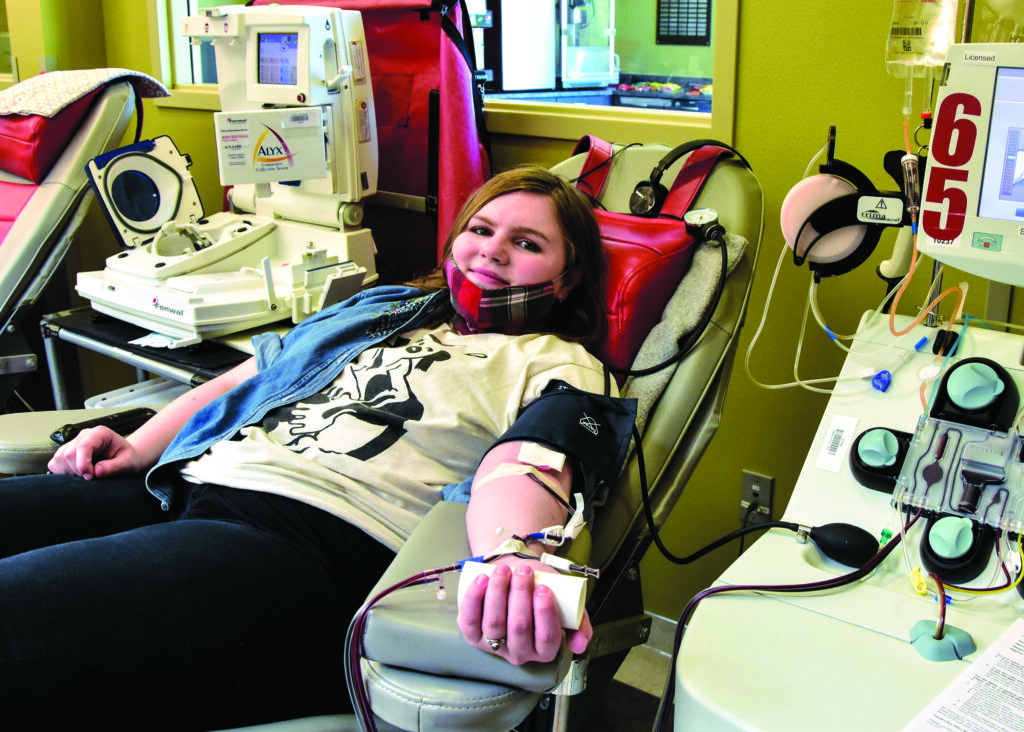
Hannah Hendrickson donates plasma at Vitalant in Fargo. After her recovery from COVID-19, her antibody-rich plasma will be used to treat as many as five victims of the disease. (Photo/Nancy Hanson)
Nancy Edmonds Hanson
The coronavirus pandemic was just peeking over the horizon when Hannah Hendrickson and her friends celebrated the advent of spring break. Then the Macalester College junior headed home to Moorhead to relax with her family.
Spring break was to prove entirely different than Hannah – along with every other students in Minnesota – anticipated. She’d only been home with her parents, Chuck and Renae Hendrickson, and her three brothers for a day or so when a friend called her from St. Paul. “We’ve been exposed to COVID-19,” the caller said. And so began two weeks of quarantine and convalescence for a young adult who’d been assuming, like so many of her peers, that the contagion was a risk to older folks and those with pre-existing conditions.
“That didn’t sound like me,” the 21-year-old political science major says, looking back. “But I did quarantine myself in my room right away to protect my family.” She booked an e-visit screening at Sanford Health; they recommended she be tested.
“They called and said the test was negative,” Hannah says. “What a relief!” But it didn’t last long. The next day, another call corrected the first: The initial result turned out to be a false negative. She was very much positive for COVID-19.
Three months after her recovery, Hannah describes her symptoms as not the sickest she’d ever been – but nothing to take for granted. “I felt like I had a bunch of illnesses all at once,” she recalls. “I had the fever you hear about. I felt like I had a weird cold, with a cough, a headache and the weirdest tickle in my throat. Mostly, though, I was so tired. I stayed in my room and slept a lot.
“I was much more scared for my family than myself,” she reflects.
A contact tracer from St. Paul called to question who she’d been in contact with before her symptoms developed, then followed up with calls to each of them. That included her parents and brothers. The Health Department checked with all six Hendricksons every day, asking them to report their condition. Hannah and mother Renae suspect that her 11-year-old brother Max may have had a mild case; since the whole family was already quarantining at home, no further care seemed necessary.
Hannah returned to her job at Caribou Coffee in St. Paul after she’d fully recovered. This summer, she is working as an intern in the office of U.S. Rep. Angie Craig. She is also involved in the Minnesota Pre-Law Scholars Program, a highly selective University of Minnesota project that prepares promising students to take the LSAT.
Hannah was back in Moorhead last week for the Fourth of July. One of the first things on her agenda was donating her antibody-rich plasma at Vitalant (formerly United Blood Services) in Fargo. The liquid extracted from her blood may be used to treat as many as five other COVID patients in an investigational study approved by the Food and Drug Administration.
There’s a family connection to that plasma. Hannah’s father Chuck is a technical writer with Aldevron of Fargo, the research firm that is producing high-quality plasmid DNA for COVID-19 research, preclinical, clinical and diagnostic applications. He is also running in the primary Aug. 11 to be the Democratic candidate for Minnesota District 4-A’s House seat.
Advice for her young peers? Hannah lays it on the line. “Yes, it can happen to you, like it happened to me. You can get infected with this disease incredibly easy. It’s not all about you – it’s about others.
“Don’t go out to bars. Wear a face mask.”


